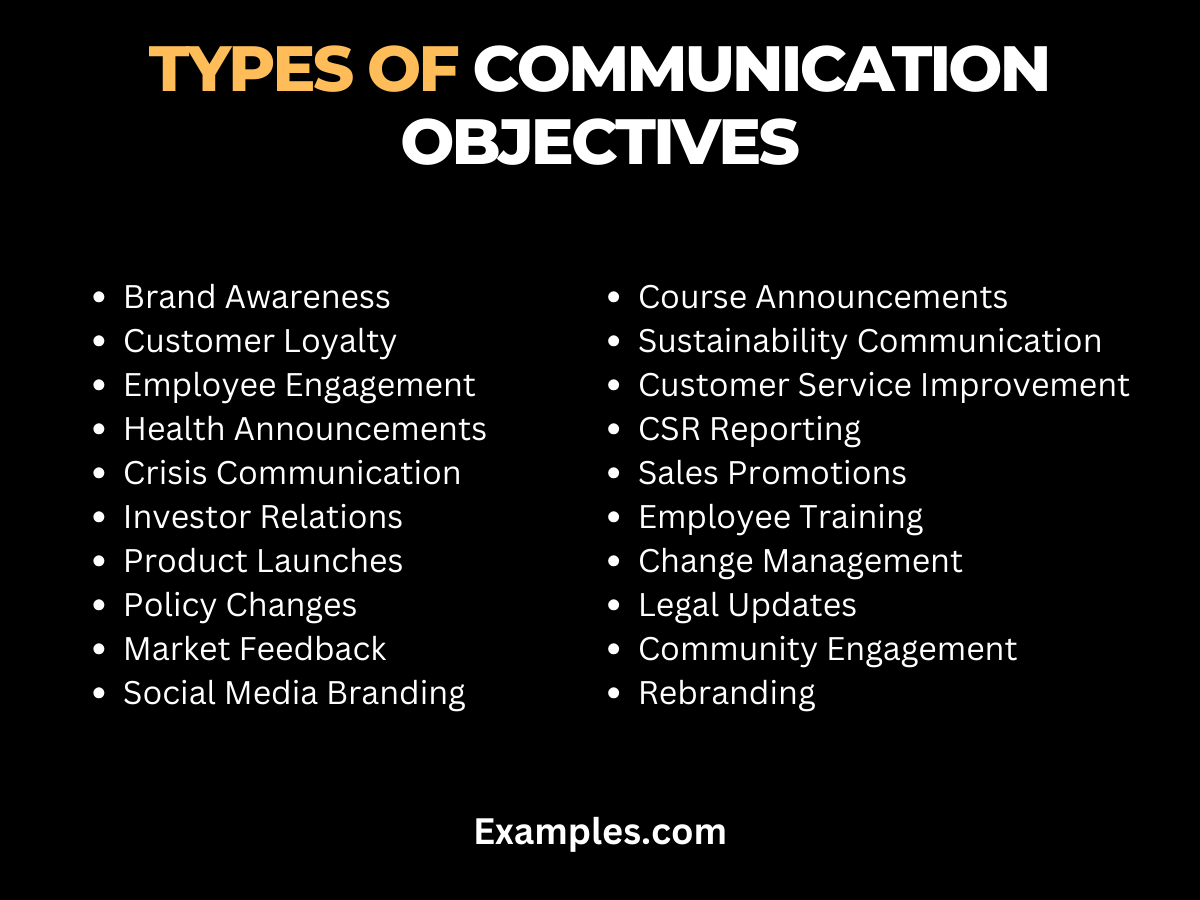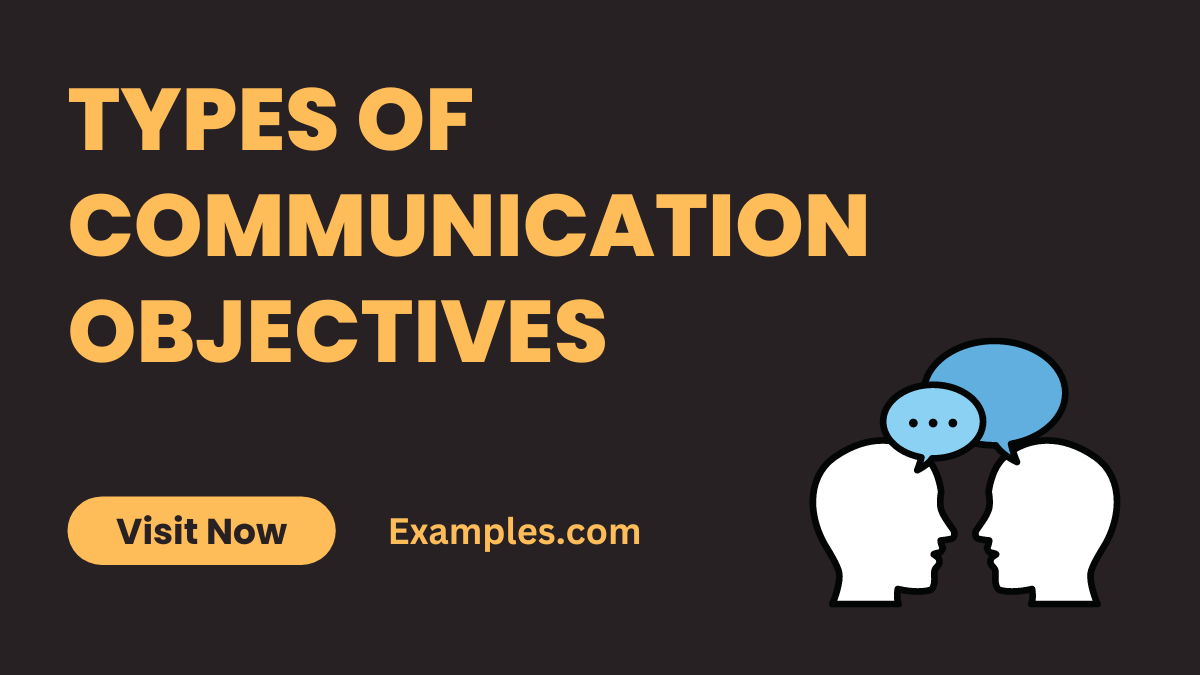19+ Types of Communication Objectives
Welcome to a detailed exploration of the Types of Communication Objectives. This guide illuminates various communication strategies, enriched with practical communication examples. Whether it’s crafting persuasive marketing messages or engaging educational material, understanding these objectives is key to successful communication. Delve into this guide to discover how different objectives can be skillfully applied in various contexts, enhancing both personal and organizational communication effectiveness.
Download Types of Communication Objectives PDF
20 Types of Communication Objectives Examples

Explore the diverse array of communication objectives in this guide, where each type is tailored to address specific communication needs and challenges. From marketing communication objectives to employee information objectives, these examples span various contexts, including advertising, corporate communication, and educational environments. Understanding these objectives is essential for crafting effective communication strategies that resonate with the intended audience and achieve the desired outcomes. Let’s delve into 20 distinct examples, each elucidating a unique communication objective, its causes, and strategies for effective implementation.
- Brand Awareness Campaigns: Aimed at introducing a brand to a new audience. Poor brand recognition is addressed by using brand messaging priorities to increase visibility.
- Customer Loyalty Programs: Focused on retaining existing customers. Customer attrition can be countered with customer relationship communication goals that emphasize value and appreciation.
- Employee Engagement Initiatives: Target employee motivation and involvement. Overcome disengagement with internal communication milestones that foster a positive work culture.
- Public Health Announcements: Convey critical health information to the public. Misinformation is tackled through public relations objectives, ensuring accurate and widespread dissemination.
- Crisis Communication Management: Handle communication during crises. Panic and confusion are mitigated with clear, concise crisis communication objectives.
- Investor Relations Updates: Keep investors informed about company performance. Uncertainty in investment decisions is reduced with organizational communication targets that offer transparency and consistency.
- Product Launches: Introduce new products to the market. Consumer unfamiliarity is addressed by marketing communication aims that highlight product features and benefits.
- Internal Policy Changes: Communicate new company policies to employees. Potential resistance is managed through corporate communication strategies that explain the rationale and benefits.
- Market Research Feedback: Collect and act on customer feedback. Misalignment with customer needs is resolved with feedback generation communication objectives.
- Social Media Branding: Establish a brand’s online presence. Lack of online engagement is countered with audience engagement communication objectives.
- Educational Course Announcements: Inform students about new courses or changes. Miscommunication is addressed with educational communication objectives that clearly outline course details.
- Sustainability Initiatives Communication: Promote eco-friendly practices within an organization. Employee indifference is tackled with awareness building communication objectives.
- Customer Service Improvement Communication: Enhance the quality of customer service. Customer dissatisfaction is reduced with focused relationship building communication objectives.
- Corporate Social Responsibility (CSR) Reporting: Share CSR activities with stakeholders. Enhance stakeholder trust building communication objectives to improve company reputation.
- Sales Promotions: Boost product sales through targeted communication. Sluggish sales are revived with sales enhancement communication objectives.
- Employee Training Programs: Educate employees on new skills or technologies. Knowledge gaps are bridged with employee information objectives.
- Change Management Communication: Facilitate smooth transitions during organizational changes. Employee resistance is minimized with strategic change communication objectives.
- Legal and Regulatory Updates: Keep stakeholders informed about legal changes. Prevent compliance issues with information dissemination communication objectives.
- Community Engagement Projects: Involve the community in projects or initiatives. Community apathy is countered with community outreach communication objectives.
- Rebranding Campaigns: Communicate a brand’s new image or position. Confusion about brand identity is resolved with targeted brand reinforcement communication objectives.
Types of Communication Objectives in Advertising?
In advertising, communication objectives focus on awareness building, brand reinforcement objective, and persuasion. The aim is to capture attention, create memorable brand associations, and persuade consumers to take action.
Types of Communication Objectives for Students?
For students, communication objectives center around educational communication, knowledge dissemination, and feedback generation. They aim to facilitate learning, encourage interaction, and provide constructive feedback.
What are the Types of Smart Communication Objectives?
Smart communication objectives are specific, measurable, achievable, relevant, and time-bound. They apply to areas like project communication Objective, digital marketing objective, and stakeholder engagement.
What are the Goals of Communication Objectives?
The goals of communication objectives include effective information sharing, audience engagement, and relationship building objective. They aim to convey messages clearly, engage target audiences, and build lasting relationships.
The Types of Communication Objectives encompass a broad spectrum of strategies, each tailored to specific goals and audiences. From enhancing brand awareness to fostering employee engagement and managing crisis communication strategies, these objectives are integral to effective and impactful communication. Understanding and implementing these varied objectives can significantly improve the clarity, effectiveness, and success of your communication efforts in any context.



